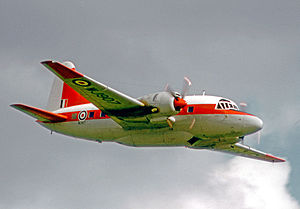Vickers Varsity
| Varsity | |
|---|---|

| |
| Varsity T.1 of No.1 Air Electronics School in 1971 | |
| Role | military trainer |
| Manufacturer | Vickers-Armstrongs |
| First flight | 17 July 1949[1] |
| Introduction | 1951 |
| Primary user | RAF |
| Number built | 163 |
| Developed from | Vickers VC.1 Viking |
The Vickers Varsity was a British twin-engined crew trainer operated by the Royal Air Force for 25 years from 1951.
Design and development
The Varsity was developed by Vickers and based on the Viking and Valetta to meet Air Ministry Specification T.13/48 for a twin-engined training aircraft to replace the Wellington T10 and the Valetta T3 and T4.[2] The main differences were the wider-span wings, longer fuselage and tricycle undercarriage.There was also a ventral pannier to allow a trainee bomb aimer to lie in a prone position and a bomb bay with a capacity for 24 x 25lb smoke & flash bombs.[2] The first prototype Type 668 Varsity VX828 was first flown by J 'Mutt' Summers and G R 'Jock' Bryce from Wisley on 17 July 1949.[2]
A civil version the VC.3 was planned but with the success of the VC.2 Viscount the idea was abandoned.[2]
Operational history

The Varsity was introduced to replace the Wellington T10 trainer. Following deliveries to trials units the first production aircraft were delivered for operational use in 1951 to No. 201 Advanced Flying School at RAF Swinderby, where they were used to train pilots to fly multi-engined aircraft. It also equipped two Air Navigator Schools in 1952, and the Bomber Command Bombing school, with the job of training crews for RAF Bomber-Command's V-bomber crews.[3]
The Swedish Air Force operated a single Varsity from January 1953 to 1973 mainly for electronic intelligence missions. The Swedish military designation was Tp 82.
The Varsity was withdrawn from service with the RAF in May 1976, its role as a pilot trainer being taken over by the Scottish Aviation Jetstream T1, and as a navigation trainer by the Hawker Siddeley Dominie T1.
The last flying example (Serial WL679) was operated by the Royal Aircraft Establishment; it was retired into preservation at the RAF Museum in 1992.
Operators


- Aeroplane and Armament Experimental Establishment
- Royal Air Force
- No. 51 Squadron RAF
- No. 97 Squadron RAF
- No. 115 Squadron RAF
- No. 116 Squadron RAF
- No. 151 Squadron RAF
- No. 173 Squadron RAF
- No. 187 Squadron RAF
- No. 192 Squadron RAF
- No. 204 Squadron RAF
- No. 527 Squadron RAF
- Bomber Command Bombing School RAF
- Central Navigation and Control School
- Royal Air Force College Cranwell
- No. 4 Flying Training School RAF
- No. 5 Flying Training School RAF
- No. 6 Flying Training School RAF
- No. 201 Advanced Flying School RAF later named No. 11 Flying Training School RAF
- No. 1 Air Navigation School RAF
- No. 2 Air Navigation School RAF
- No. 3 Air Navigation School RAF
- No. 6 Air Navigation School RAF
- No. 1 Air Electronics School RAF
- No. 1 Radio School RAF
- Royal Aircraft Establishment
- Empire Test Pilot's School
Aircraft on display
Germany
- WF382 – Varsity T.1 in storage at Berlin-Tegel Airport for the Allied Museum in Berlin.[4]
Sweden
- 82001 – Tp 82 on static display at the Swedish Air Force Museum in Linköping, Östergötland.[5][6]
United Kingdom
- WF369 – Varsity T.1 on static display at the Newark Air Museum in Newark, Nottinghamshire.[7][8]
- WF372 – Varsity T.1 on static display at the Brooklands Museum in Weybridge, Surrey.[9][10]
- WJ903 – Varsity T.1 nose section on static display at Aeroventure in Doncaster, South Yorkshire.[11]
- WJ945 – Varsity T.1 in storage at the Classic Air Force in Coventry, West Midlands.[12]
- WL626 – Varsity T.1 on static display at the East Midlands Airport Aeropark in Castle Donington, Leicestershire.[13]
- WL679 – Varsity T.1 on static display at the Royal Air Force Museum Cosford in Cosford, Shropshire.[14][15]
Specifications (T Mk 1)
Data from Vickers Aircraft since 1908.[16]
General characteristics
- Crew: four
Performance
Armament
- Bombs: 600 lb (272 kg) practice bombs in an external pannier
See also
Related lists
References
Notes
- ^ Thetford 1957, p. 448.
- ^ a b c d Martin 1975, p. 9.
- ^ Rawlings 1971, pp. 172–173.
- ^ "Airframe Dossier - VickersVarsity, s/n 8872M RAF, c/n 541". Aerial Visuals. AerialVisuals.ca. Retrieved 6 June 2017.
- ^ "TP 82". Flygvapenmuseum. Retrieved 6 June 2017.
- ^ "Flygplan [82001]". Kringla. Retrieved 6 June 2017.
- ^ "Aircraft List". Newark Air Museum. Retrieved 6 June 2017.
- ^ Ellis 2008, p. 170.
- ^ "Vickers 668 Varsity T.1". Brooklands Museum. Brooklands Museum Trust Ltd. Retrieved 6 June 2017.
- ^ Ellis 2008, p. 207.
- ^ "Aircraft List". AeroVenture. South Yorkshire Aircraft Museum. Retrieved 6 June 2017.
- ^ "A NEW KIND OF WELLINGTON". Classic Air Force. Classic Air Force. Archived from the original on 8 September 2015. Retrieved 6 June 2017.
- ^ "Aeropark Exhibits". East Midlands Aeropark. Aeropark Heritage Aircraft Collection. Retrieved 6 June 2017.
- ^ "Vickers Varsity T Mk I". Royal Air Force Museum. Trustees of the Royal Air Force Museum. Retrieved 6 June 2017.
- ^ Simpson, Andrew (2012). "INDIVIDUAL HISTORY [WL679]" (PDF). Royal Air Force Museum. Royal Air Force Museum. Retrieved 6 June 2017.
- ^ Andrews and Morgan 1988, p. 416.
Bibliography
- Andrews, C.F. and E.B. Morgan. Vickers Aircraft since 1908. London: Putnam, 1988. ISBN 0-85177-815-1.
- Ellis, Ken. Wrecks & Relics. Manchester, UK: Crécy Publishing, 21st edition, 2008. ISBN 978-0-85979-134-2.
- Martin, Bernard. The Viking, Valetta and Varsity. Tonbridge, Kent, UK: Air-Britain (Historians) Ltd., 1975. ISBN 0851300383.
- Rawlings, J.D.R. "Vickers Varsity". Air Pictorial, Vol. 33, No. 5, May 1971, pp. 172–176.
- Thetford, Owen. Aircraft of the Royal Aircraft 1918-57. London: Putnam, 1st edition, 1957.
